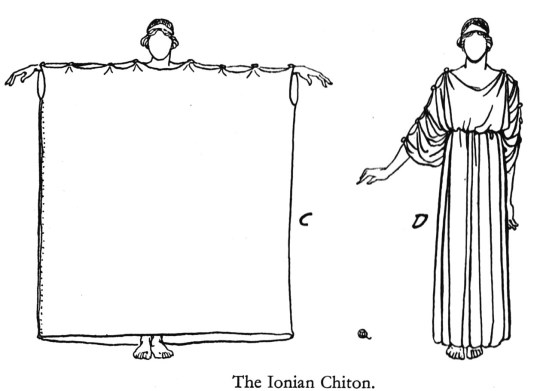Hiya! This is @blistermonster's crafting and Breyer custom blog. I am a crafty goblin.
Don't wanna be here? Send us removal request.
Text

My friends and I are going to watch Robin Hood and we are very excited to see Richard. @brightbirdart @onefamiliarsong
5 notes
·
View notes
Text
How to Make Your Own Binder that Fits Well and Looks Good
A while back I was in need of some new binders and thought hey, I bet I can make one way cheaper than buying it from somewhere (especially cus some of the ones I’ve bought in the past didn’t really fit right). Except when I started looking for a binder patterns online, I was very surprised that I really… couldn’t find many that looked very nice lol. Most of them had really wrinkled necklines, or didn't bind well, or just overall looked weird. A lot of the patterns also required a serger, which I don't have.
So I just said fuck it and made my own pattern! And it ended up being relatively easy! And the binders fit REALLY WELL and are comfortable to wear, even for long periods. The neckline doesn't show under shirts with loose collars, and the bottom hem doesn't gap or stick out. Here's me wearing one:
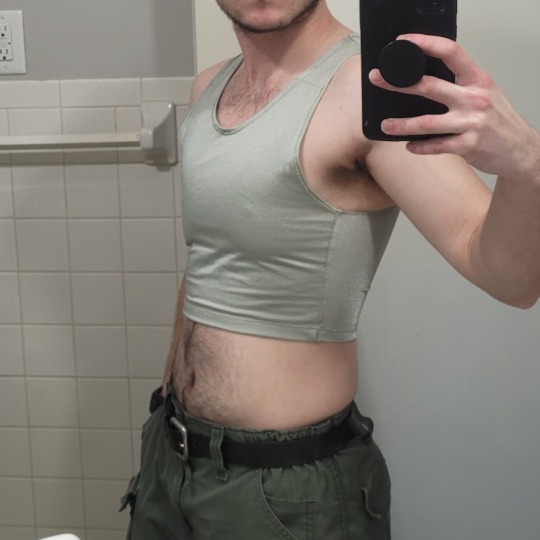
(plus I was able to make myself 5 of them for a total of like ~$50.)
So I figured I could throw together a guide to help out anyone else who wanted to make their own binder but was dissatisfied with the patterns available!
Disclaimer: This tutorial is going to assume a baseline level of sewing experience, and also will require access to a sewing machine. It is not a complicated pattern, but it will most likely require some tweaking and adjustments after you make the first one. Don’t be afraid to make alterations to make it fit better!
This tutorial is for a gc2b-style half-tank binder. It could be altered to be a full-tank binder, but all instructions will be for the half-tank design.
Materials needed:
Stretchy fabric, probably listed as 'athletic fabric' (I use this kind from Joann’s. Most athletic stretch fabrics should work, look for around 80% nylon/20% spandex blends)
Stiff fabric (I use this shirting cotton because I like how lightweight it is. If you want something a little stiffer with more structure, you can use a cotton or cotton/poly blend twill like this. gc2b binders use twill for theirs.)
Lightweight fusible interfacing (I use this kind) (get FUSIBLE not sew-in)
Fusible webbing like Pellon Wonder-Web (this is technically optional but it WILL make your life easier when you’re sewing - just make sure to get the kind with the paper backing!!!)
“But kiwisoap thats 4 whole kinds of materials, surely I don’t need that many!” Ok sure, you can probably get by without the fusible web and interfacing, but consider: they are both dirt cheap (im talking like $1-2/yard), they will make it much easier to sew the final product, and will give you an overall better-looking result. This tutorial is written with the assumption that you’ll use them.
"How much fabric will I need?" Measure the circumference of your chest below your armpits. Add 6 inches just to be safe. This is the yardage of stretch fabric you’ll need, and should give you enough material to make at least 3 binders without much excess left over. You will need around half as much stiff fabric.
Other supplies:
Big Paper (for drawing the pattern)
Flexible measuring tape
Sewing machine
Iron
Pins
Step 1: Measuring
You will need 4 main measurements for this pattern.

A) Measure the circumference of your chest just below your armpits, then divide the number in half. This will be the widest part of the pattern.
B) Measure from the top of your shoulder down to where you want the binder to end. For most folks, this will usually be around the natural waist (narrowest part of the torso), about 3-6 inches above the belly button. This will be the overall height of the pattern.
C) Measure the distance from below your armpit to where you want the binder to end. This will determine where the arm hole starts.
D) Measure the circumference of your waist where you want the binder to end, then divide the number in half.
So for example, after dividing A and D in half, my measurements are 17", 15", 7", and 14.5".
Next:
Subtract one inch from measurement A - This will help provide some compression. You might need to take it in even further depending on how it fits, but one inch is a safe starting point. I take mine in around 1.5 inches.
Subtract half an inch from measurement D. This will help prevent the bottom edge of the binder from gapping. Again, you may need to take it in more or less, depending on your own body.
Add 1.5 inches to measurement B and one inch to measurement C. This is to account for the hems and armhole placement.
This makes my final measurements
A = 16"
B = 16.5"
C = 8"
D = 13.5"
From here on out, we are only going to be working with the measurements that we have added/subtracted to, NOT the ones we initially took.
Step 2: Drawing the Pattern
You will need a piece of paper large enough to accommodate the entire pattern. This may involve taping multiple pieces together, or using a piece of newsprint, etc.
I recommend folding the paper in half to ensure that you get a symmetrical pattern. However, this means you will need to divide measurements A and D in half again, or else you’ll end up with a pattern that’s twice as wide as it should be!
Also note: the pattern is drawn with the seam allowance built in! You don’t need to add any seam allowance.
To draw the pattern:
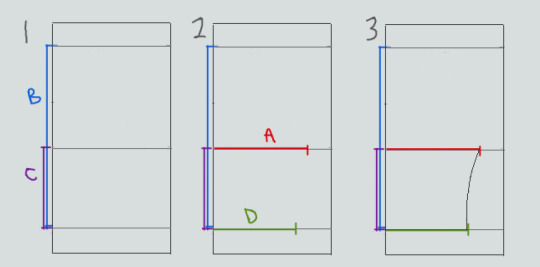
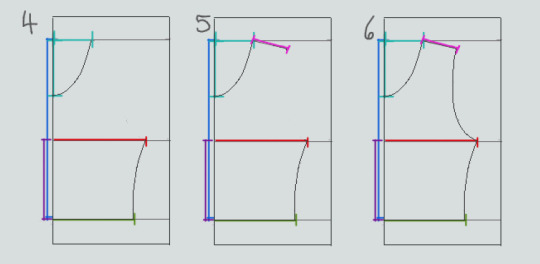
Begin with your folded paper. Measure and mark B and C on the paper, and draw a line extending across the paper. These will be your guidelines.
Measure and mark A and D along the middle and bottom guidelines, respectively. Remember, the paper is folded, so you only use half of the measurement for A and D.
Draw a loose curve connecting the endpoints of A and D. If needed, you can also just draw a straight line between the two.
Mark the opening for the neck hole. Depending on your size, it will measure around 6-8 inches across at the top (remember to divide this in half for the folded paper) and about 5-6.5 inches deep. (mine is 6.5" across and 5.5" deep) Draw a curve to connect the two points. This part will take some tweaking and adjusting to get it to look right lol.
Measure the width of the strap - this should be somewhere between 2.5 - 4 inches wide. They will end up about 1/2” to 3/4” narrower once you sew them. Draw the line at a slight angle, as shown.
Connect the endpoint of the strap to the endpoint of line A with a curve like in the diagram.
This will be the pattern for the front piece.
To make the back piece, trace the front pattern, but make a very shallow curve for the neckline instead of a steep one, as shown:
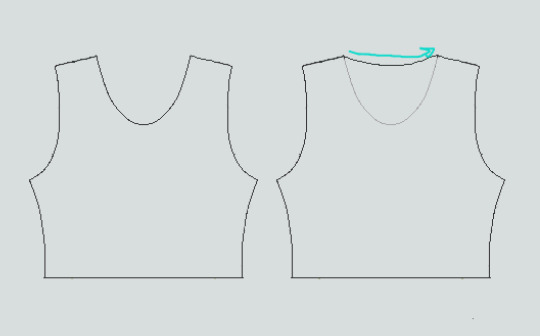
The last piece is the stiff front panel. This is what provides the flattening effect of the binder. To make the pattern, trace the front pattern again. Trim 3/8” in on the sleeves and neckline, and 3/4” to 1” along the bottom. This gives a flatter hem. Then trim the straps shorter by a few inches. This helps the binder lay flatter along the shoulders.
When you're done, you should have 3 pattern pieces that look approximately like this (stiff panel shown overlaid on the stretch fabric to show how it fits together).
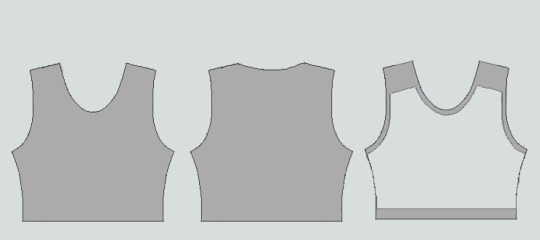
NOTE: If you want more compression or just want to make it a bit sturdier, you can add a second panel of stretch fabric to the back piece. Just use the bottom half of the back pattern (from the widest part down to the bottom hem) to cut out another piece of stretch fabric. Attach it to the back piece with a strip of fusible webbing and a zig-zag stitch along the top.
Step 3: Putting It All Together
Once you’ve made the patterns and cut out the pieces of fabric, you should have something that looks like this:
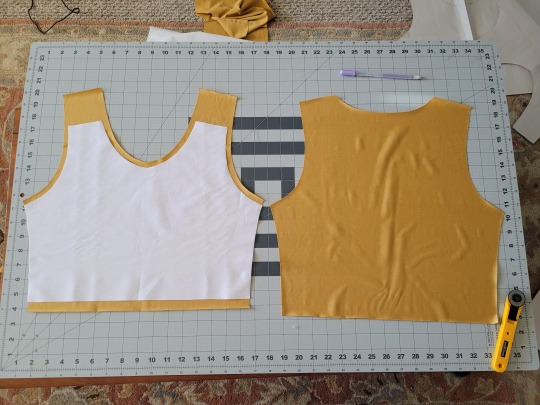
The next step is adding interfacing and fusible webbing. Use your pattern to cut out 3/8" strips to fit on the top of the straps for both pieces, and to the neckline, sleeves, and bottom hem of the back piece, as shown:
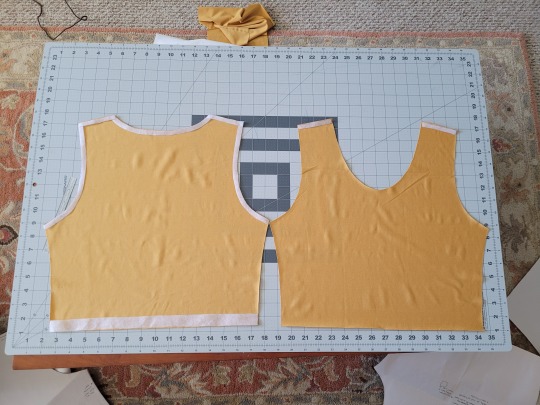
If you want to add it to the bottom hem of the front piece, it will help keep that hem flat when sewing it down later, but it's not essential.
If you choose to also use fusible webbing (WHICH I RECOMMEND), you will apply it to the stiff front panel similarly to how the interfacing was applied, ~3/8” strips along the neckline, sleeves, and top of the straps. Cut out two strips for the neckline and sleeves, because we'll use those later too.
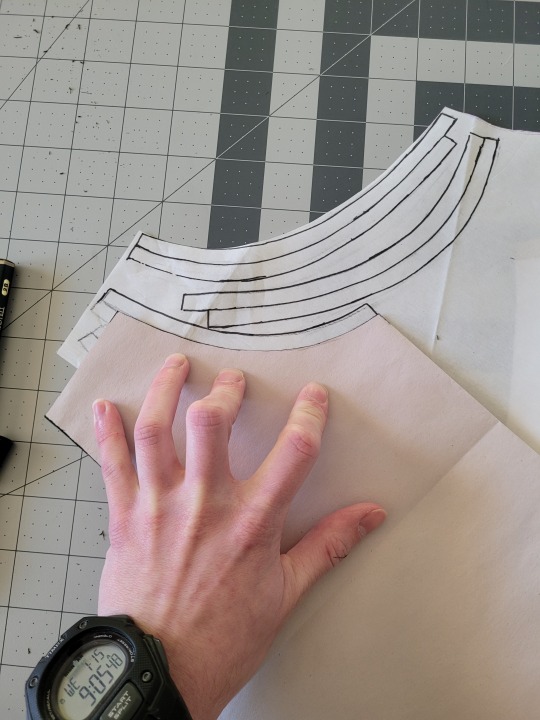
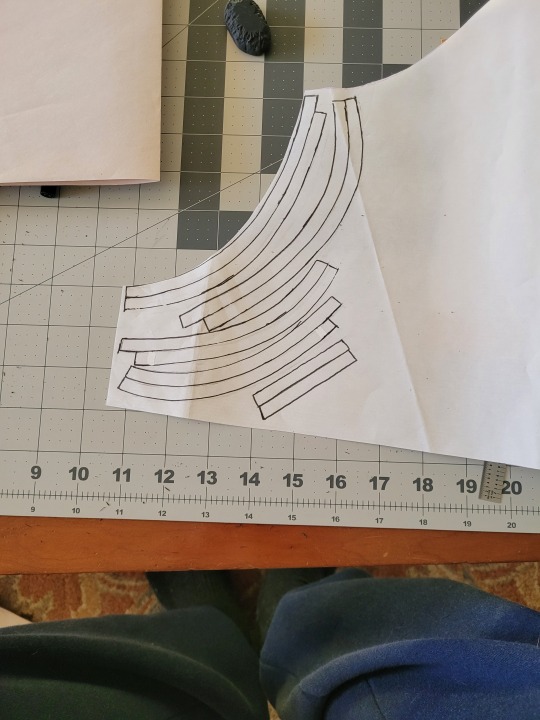
Iron the strips onto the front panel as shown:
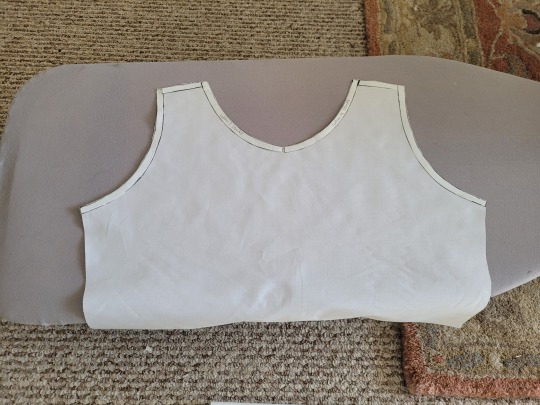
Once it's on, just peel off the paper, position it webbing-side down on the stretch fabric, and iron it to fuse the two pieces together so everything stays in place while you sew. THIS MAKES IT WAY EASIER TO SEW.
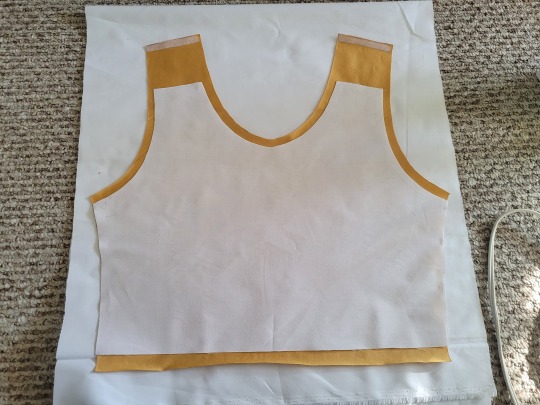
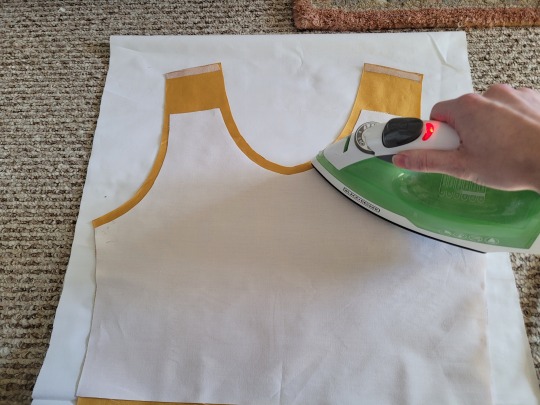
After the stiff front panel is fused to the stretch fabric, you’ll sew the straps of the front and back pieces together, then join the pieces along the sides. Pin the hell out of it to keep everything in place -this type of material is VERY prone to puckering.
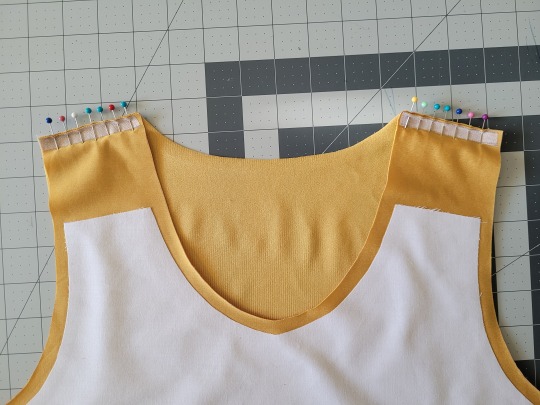
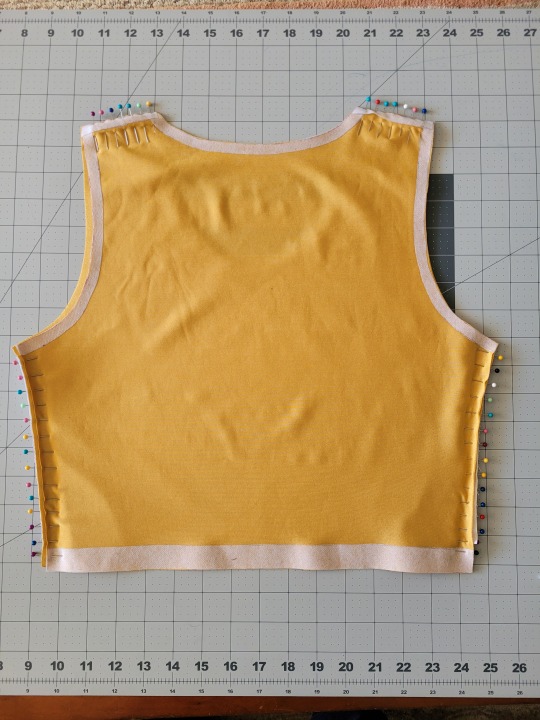
When sewing, USE A ZIGZAG STITCH. A straight stitch will NOT WORK for stretch fabric. I adjust mine to 1.3mm long and 3.5mm wide which has worked well. If your machine doesn’t let you adjust stitch length or width, well. That sucks, I don’t really have any advice.
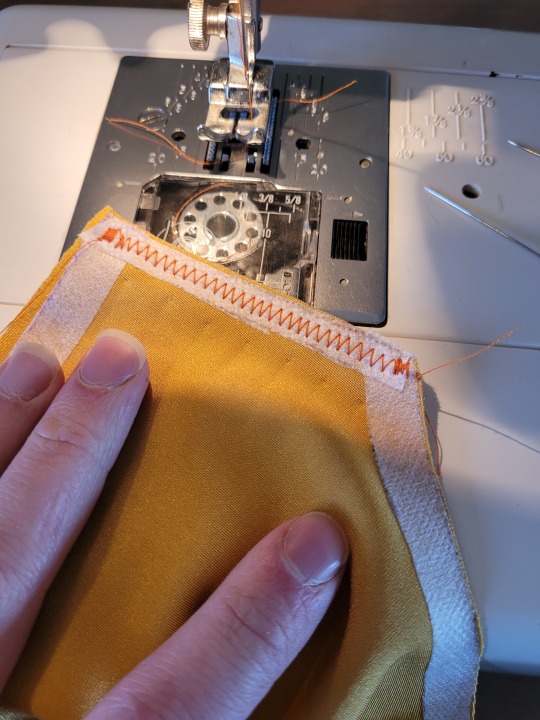
After you sew the front and back pieces together, you can add more fusible webbing to the front panel to help hold the hem down flat and prevent it from puckering while you sew it. Just add the strip, peel the paper off, then fold the hem over and iron it down. This part isn’t really necessary, but it does make the hems look nicer. If nothing else, I would recommend adding it to the neckline.

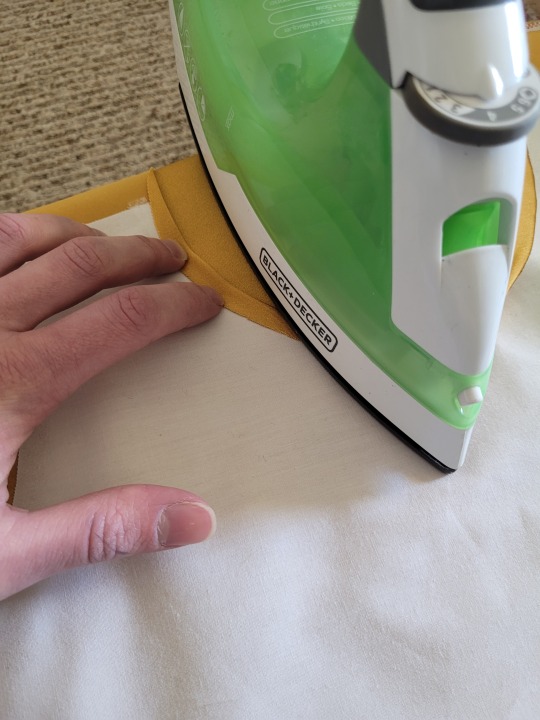
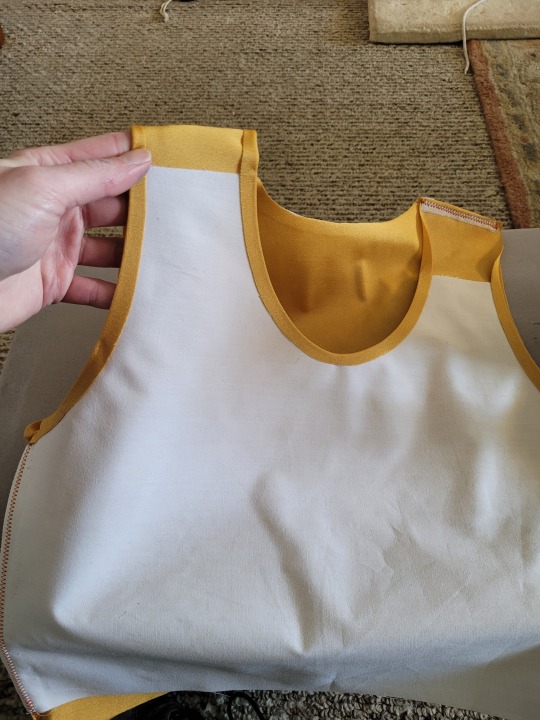
After that, you just fold & pin all the hems and sew them up with a zigzag stitch, then go over the raw edge at the top of the stiff panel (where we cut the straps shorter).
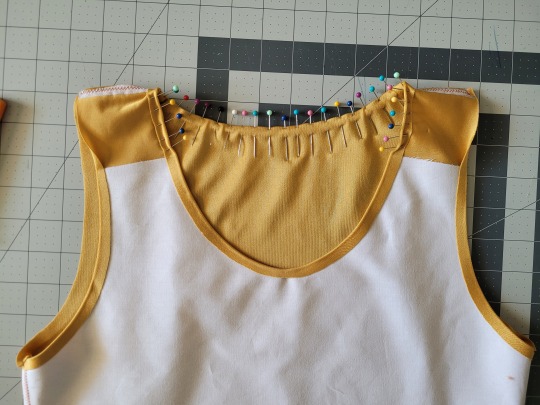
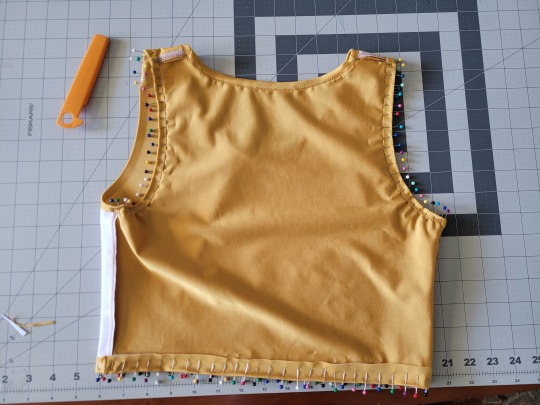
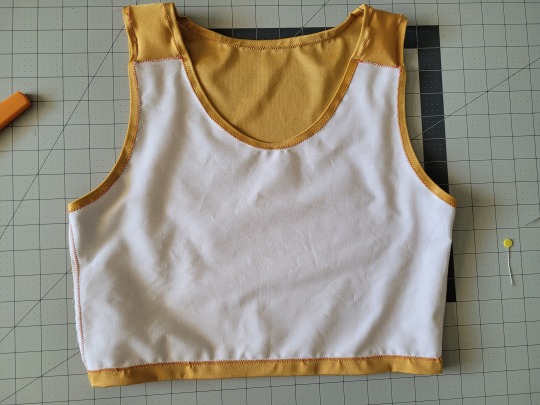
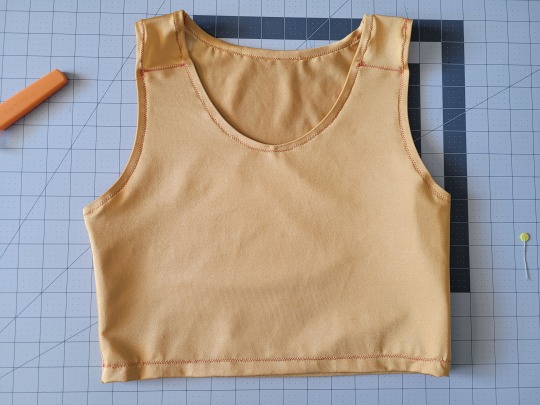
And that’s it! You’re done! And now you can make your own binders whenever you want!
And hey! If you used this tutorial and wanna throw me a dollar or two on ko-fi, I wouldn't complain.
2K notes
·
View notes
Text

PDF pattern + instructions - Sleepy Kitty Cat - DIY by Piquipauparro
169 notes
·
View notes
Text








Another zipper pencil case!
My partner requested some "high visibility" zipper pouches that we can take camping. I used one layer of Odicoat gel on the exterior fabric for water repellency. I added a lobster claw, and a high-contrast zipper pull.
Modified from this tutorial by Orange Bettie [x]
I didn't print the pattern, I just measured and cut:
11" x 5", two pieces in Exterior and Lining
10" x 4.5", two pieces in Fusible (because my fusible comes in a 20" width and this let me get two pieces from one strip)

In the Exterior and Lining pieces, measure and mark:
from the long edges, inward by 1 ¾ inches
from the short edges, inward by 1 ¼ inches
you want to cut out the little rectangle you just drew, so I marked it with an X
To make this easier for myself, I used adhesive index tabs to mark these on my Omnigrid ruler.

On the Fusible, you want the X-ed rectangle to have a 1/4 inch clearance on 3 sides. Since my fusible is somewhat see-through, here's what I did to make it easier: lay the fusible over top the already-marked fabric and centre it. Line up the quilting ruler so it's a ¼ inch inward from the X-ed rectangle, and draw your lines.
Or you could just eyeball it.
13 notes
·
View notes
Text



My recent sewing projects :-)
Dm / comment for sewing patterns thanks!!
Commissions open as well DM me ;)
35 notes
·
View notes
Text


The Cozette Dress - PDF PATTERN by AllisPatterns
311 notes
·
View notes
Text
🌷How to Sew 5 Tulip Sleeve Designs: A Step-by-Step Tutorial with Free PDF Pattern for Biginners !🌷
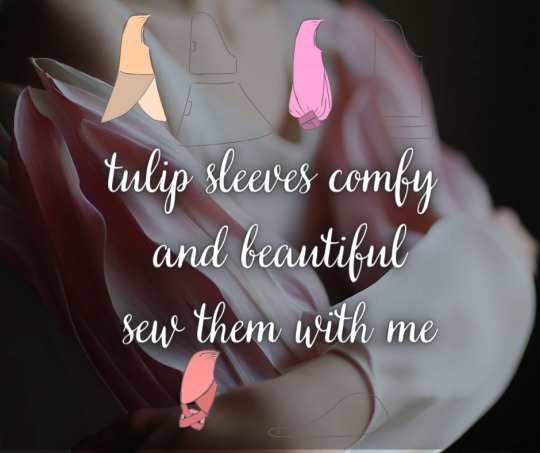
Hey there! Today, I'm thrilled to share with you an exciting and trendy topic – tulip sleeves! 🌸✨ These delightful sleeve designs add a touch of sophistication and charm to any garment, and I can't wait to show you how to create them step by step.
In my latest YouTube video, I'll guide you through the magic of sewing tulip sleeves with an easy-to-follow tutorial. Whether you're a seasoned sewist or just starting your sewing journey, this guide is designed to make you a sleeve expert! 🧵💖
And guess what? To make your sewing experience even more enjoyable, I've prepared a FREE PDF pattern for tulip sleeves in 5 sizes. 🎁💕 Now you can effortlessly customize your sleeves to suit your unique style and measurements!
Get ready to transform your wardrobe and take your fashion game to the next level with these exquisite tulip sleeves. 🌺🌟 Check out the full tutorial on my YouTube channel and let your creativity bloom!
Join me on this journey of creativity, elegance, and craftsmanship – let's sew beautiful tulip sleeves and unlock a whole new level of fashion! 🌷✂️
Pattern and all baners you will find here
step by step video how to hack my PDF pattern and sew your dream tulip sleeves you will find here

132 notes
·
View notes
Text

Digital Sewing Pattern - Walden the Crow Plush with Backpack by RayleeArtShop
433 notes
·
View notes
Text

Pixie Sewing Kit. PDF Pattern. by RosieTaylorCrafts
280 notes
·
View notes
Text


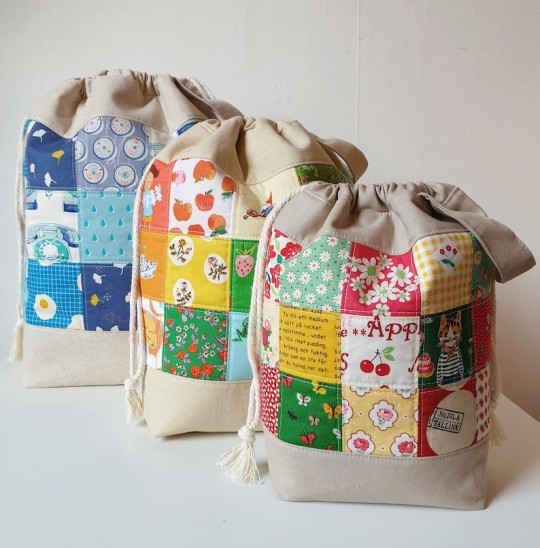


Fun, easy-to-follow sewing patterns by RosieTaylorCrafts
1K notes
·
View notes
Text
this messed up vintage cat sewing pattern has tormented me since i saw it & like some other folks have done in that post - i tried my hand at tweaking the pattern to resemble the illustration (and my personal tastes) a little more. i've ended up with this. i bestow it upon you nice folks now 👐
(update 2, added instructions & it's also on my Kofi!)



go forth and make weird little beanbag kittens! pls show me if you do!
46K notes
·
View notes
Text

Coming soon, a self indulgent lil zine for your kitchens
491 notes
·
View notes
Text
Hey fam! Over much deliberation I'm moving my craft blogging over to my main account @blistermonster. I do a lot of creative things, and I don't want to keep them separate anymore!
Take da drawing, take da yarn, make hold hands.
0 notes
Text


Blocking these today! I'm so excited to have some mitts for working in my chilly office this winter!
Underwing Mitts!!
170 notes
·
View notes
Text

Hey yall! I have open commission slots! If you or someone you know wants a character, family member, pet drawn, or if you just want some cool art, check out my commission sheet and hit me up!
2 notes
·
View notes

